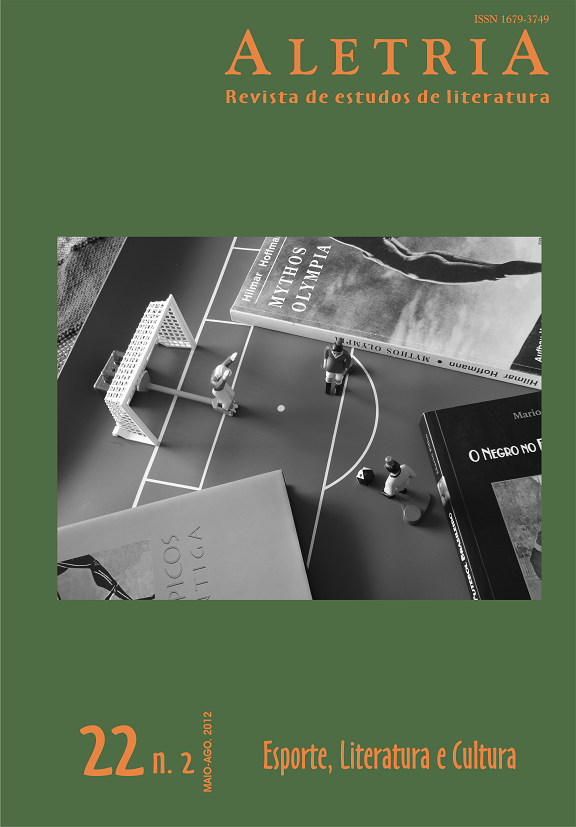Figured Football: The Language of Cartoons and Comic Books in the Sports Chronicles of José Lins do Rego
DOI:
https://doi.org/10.17851/2317-2096.22.2.29-44Keywords:
football, mass culture, club narrativesAbstract
This paper analyzes the incidence of cartoons and comic books characters in sports chronicles written by José Lins do Rego from 1945 to 1957. It is argued that the frequent presence of figurative language in the novelist’s column in Jornal dos Sports should be considered more than an author’s idiosyncrasy or some kind of expressive ornament. Such language constitutes a communication strategy, for the author used large extracts of discourse of football fans, especially from supporters of clubs in Rio de Janeiro. Based on a more general debate on the question of narrative in chronicles and the spread of mass culture in Brazil through US juvenile comic books, we are able to see how Lins do Rego used this communicative strategy to foster club identity in Rio de Janeiro. The sports chronicle was a means for the author to get closer to the universe of supporters through mechanisms of identification and passional affiliation to the most popular football teams in Rio de Janeiro in the mid-twentieth century.
Downloads
References
ANDRADE, Mario de. Fantasia de Walt Disney. In: ANDRADE, Mario de. O baile das quatro artes. São Paulo: Martins, 1975. p. 67-83.
ARQUIVO Histórico do Jornal dos Sports. Rio de Janeiro: 1945-1957.
BAKHTIN, Mikhail. A cultura popular na Idade Média e no Renascimento: o contexto de François Rabelais. Trad. Yara Frateschi Vieira. São Paulo: Hucitec, 2008.
CALDAS, Waldenyr. Cultura de massa e política de comunicações. São Paulo: Global, 1986.
CANDIDO, Antonio. A vida ao rés-do-chão. In: CANDIDO, Antonio. Recortes. São Paulo: Companhia das Letras, 1993. p. 23-29.
COELHO, Teixeira. O que é indústria cultural? São Paulo: Brasiliense, 1980.
GINZBURG, Carlo. O queijo e os vermes: as idéias e o cotidiano de um moleiro perseguido pela inquisição. Trad. Maria Betânia Amoroso. São Paulo: Companhia das Letras, 1987.
LEITE LOPES, José Sérgio. A vitória do futebol que incorporou a pelada. Revista da USP – Dossiê Futebol, São Paulo, n. 22, p. 64-83, jun. 1994.
LIMA, Herman. História da caricatura no Brasil. Rio de Janeiro: José Olympio, 1963. 2 v.
NEVES, Margarida de Souza. História da crônica. Crônica da história. In: RESENDE, Beatriz (Org.). Cronistas do Rio. Rio de Janeiro: J. Olympio, 1994. p. 15-31.
NUNES, Benedito. Oswald canibal. São Paulo: Perspectiva, 1979.
PEREIRA, Leonardo Affonso de Miranda. Footballmania: uma história social do futebol no Rio de Janeiro (1902-1938). Rio de Janeiro: Nova Fronteira: 2001.
PESSOA, Flávio Mota de Lacerda. Humor político e social nas charges de Lorenzo Molas e Henfil no Jornal dos Sports. Projeto de Qualificação de Mestrado. Programa de Pós-Graduação em História Comparada (UFRJ). Rio de Janeiro: 2012.
RODRIGUES FILHO, Mario. O negro no futebol brasileiro. Prefácio de Gilberto Freyre. Rio de Janeiro: Mauad; FAPERJ, 2003.
SÁ, Jorge de. A crônica. São Paulo: Ática, 1985.
SCHWARCZ, Lilia Moritz. O complexo de Zé Carioca: notas sobre uma identidade mestiça e malandra. Revista Brasileira de Ciências Sociais, São Paulo, n. 29, out. 1995.
SILVA, Marcelino Rodrigues da. Mil e uma noites do futebol: o Brasil moderno de Mario Filho. Belo Horizonte: Ed. UFMG, 2003.
SOARES, Antônio Jorge. Futebol, raça e nacionalidade no Brasil – releitura da história oficial. 1998. Tese (Doutorado em Educação Física). Universidade Gama Filho, Rio de Janeiro.
SOARES, Antônio Jorge; HELAL, Ronaldo; LOVISOLO, Hugo. A invenção do país do futebol: mídia, raça e idolatria. Rio de Janeiro: Mauad, 2003.
Downloads
Published
How to Cite
Issue
Section
License
Copyright (c) 2012 Bernardo Borges Buarque de Hollanda (Autor)

This work is licensed under a Creative Commons Attribution 4.0 International License.
Authors who publish with this journal agree to the following terms:Authors retain copyright and grant the journal right of first publication with the work simultaneously licensed under a Creative Commons Attribution Non-Commercial No Derivatives License that allows others to share the work with an acknowledgement of the work's authorship and initial publication in this journal.Authors are able to enter into separate, additional contractual arrangements for the non-exclusive distribution of the journal's published version of the work (e.g., post it to an institutional repository or publish it in a book), with an acknowledgement of its initial publication in this journal.Authors are permitted and encouraged to post their work online (e.g., in institutional repositories or on their website) prior to and during the submission process, as it can lead to productive exchanges, as well as earlier and greater citation of published work (See The Effect of Open Access).





